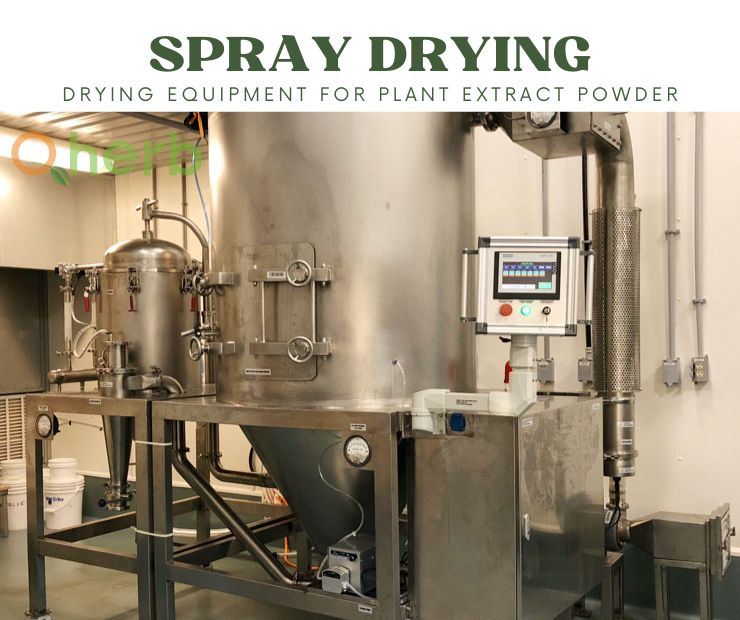Ten Key Principles of Spray Drying, an Important Drying Equipment for Plant Extract Powder
Each spray drying equipment consists of seven systems: feeding pump, atomizer, air heater, air distributor, drying chamber, dust recovery system, and exhaust gas cleaning system.
To truly understand spray drying, it is necessary to grasp the following ten key principles:
- Atomization: Using an atomizer to disperse the liquid material (which can be a solution, emulsion, suspension, or melt) into uniform droplets.
- Contact between droplets and hot air: Hot air, distributed evenly by the hot air distributor, enters the drying chamber, where it mixes thoroughly with the droplets and moves according to certain rules (the contact between air and droplets can be concurrent, countercurrent, or mixed flow).
- Drying process: Due to their large surface area and significant “gradient” in temperature and humidity compared to the hot air, these droplets enhance the process of heat and mass transfer, causing the water content within them to rapidly vaporize and evaporate (typically within a few seconds to tens of seconds), forming product particles.
- Gas-solid separation: Separating the product particles from the air, while the wet exhaust gas is thoroughly treated for dust removal to meet emission standards before being released into the atmosphere.
- Atomization: The form of the spray material with the desired liquid size distribution is crucial for the successful operation of any spray dryer. Therefore, the atomization system of spray drying equipment must ensure uniform droplet size distribution to produce particles that meet standards and required specifications.
- Atomizer: Three common types of atomizers are used in industrial production:
- Rotary atomizer: Atomization occurs due to centrifugal force.
- Pressure nozzle atomizer: Atomization is driven by pressure.
- Two-fluid nozzle atomizer: Atomization is induced by kinetic energy. The choice of atomizer depends on the nature of the raw material and the specifications of the dried product. When multiple atomizers can be used, rotary atomizers are usually preferred for their greater flexibility and ease of operation.
- Concurrent flow: The hot air and droplets flow in the same direction inside the drying chamber. The temperature of the particles “precipitated” from the drying chamber at this time will be lower than the temperature of the exhaust gas. This is an ideal method for heat-sensitive products. If a rotary atomizer is used, the hot air distributor disperses high-speed rotating airflow to maintain a constant temperature inside the drying chamber. Drying equipment equipped with nozzle atomizers typically uses non-rotating hot air flow, with equally excellent results.
- Countercurrent flow: The hot air and droplets flow in opposite directions inside the drying chamber. This method is suitable for products that require preheating during drying. The temperature of the particles discharged from the drying chamber at this time will be higher than the temperature of the exhaust gas.
- Mixed flow: Particle movement through the drying chamber undergoes both concurrent and countercurrent stages. This mode is suitable for thermally stable products. In these products, coarse powders must be sprayed from bottom to top using nozzle atomizers into the counter-flowing hot air. For processing heat-sensitive products, the atomizer should spray droplets downwards into the gathered fluidized bed, with the inlet and outlet both located at the top of the drying chamber.
- Spray drying process: The spray drying process involves dispersing liquid raw materials into droplets within the drying chamber and drying the droplets with hot air to obtain the product. Droplets can be achieved through rotary atomizers or nozzle atomizers. Drying of droplets can be accomplished by adjusting the temperature of the drying medium (usually air) or controlling the medium flow rate. Raw materials can be solutions, emulsions, suspensions, melts, or pastes. The dried product can be processed into powder, granules, hollow spheres, or agglomerates as required.

Comments
Post a Comment